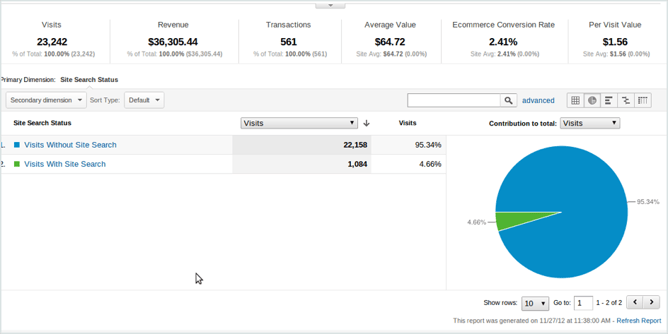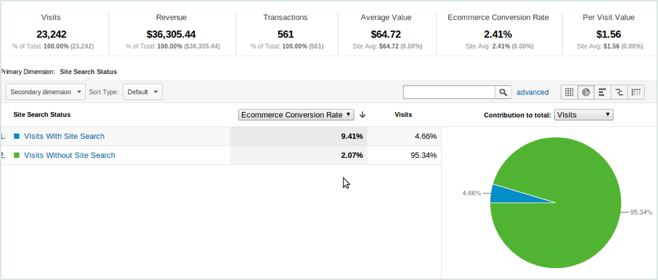1. Find out how much your site search is used to today and how those particular visitors behave.
Look into how much revenue stems directly from visitors who search and what your current search conversion rate is. You can use Google Analytics (Content > Site Search > Usage) to know whether or not users are actively using product search and how they convert. You will notice that visitors who site search often convert at twice the rate or more compared to visitors without site- search.


2. Design a more appealing search box
One of the possible reasons your visitors may not be using your product search is the placement of your search box. It used to be that having a limited catalogue justified having poor site search (i.e. people would just browse), but growth in mobile shopping kills this argument (have you ever browsed hundreds of products on a mobile phone in search of something specific? Not fun!).
6 tips for designing a great search box:
|
3. Test your search for accuracy
Search for words (singular, plural, misspelled) and see if the same results appear. For example, if you're in sporting goods, a search for 'basketball', 'basketballs' and 'bascetblls' should all return the same results.
4. Test your search for relevancy
Search for a popular product type term and see if other similar products also come up. For example, if you're a grocery retailer, a search for 'cookie' should also yield products described as biscuits, wafers and oreos.
5. Offer a list of Related Results to drive product discovery
Consider presenting a secondary list of results that are "related" to the products that come up as direct search results. A sort of “you might also like” list. For example, if you're a grocery retailer, a search for 'Red Bull' should trigger a side list of results that includes other types of energy drinks and products; a search for 'lemon' should bring up a list of other citrus fruit like limes and grapefruit.
6. Use behavioural data to refine search results ranking
Great search should learn and get better over-time. Use actual visitor clicks, add-to-baskets and purchases to refine what results are most relevant to a particularly query and should appear on top. One downside to this feature is the cold start problem - it can take a significant amount of time to accumulate enough behavioural data to draw any conclusions.
7. Continuously work to improve the quality and structure of your product data
Forrester research shows that 71% of online shoppers actively research product information online to help them make better purchase considerations. Centralizing and structuring product data using Product Information Systems (PIM) helps you ensure consistency of information across channels, scale your product assortment and support increasingly demanding channel distribution partners. And it also greatly improves site search functionality. At a minimum, great site search requires your product metadata to include: product identifier, title, description, image url, brand/make/supplier, product series name, category path (category 1, category 2, etc.), price and in-stock flag.
8. Consider outsourcing site search to a 3rd party
Building great search is hard! Building and maintaining search in-house is time consuming and tedious; often requiring a staff of 1-5 people solely dedicated to the issue of search. And relying on the default search functionality of your eCommerce platform is not the best solution either. Search is not their core competency, and in most cases these platforms prefer to outsource search functionality to a specialized 3rd party.
Finally, providing search that's truly relevant and that learns from user behaviour requires building sophisticated algorithms. So if you aren't keen on hiring in-house mathematicians, consider a service like Loop54 instead.
This piece is part of a longer article entitled: Site Search, the Missing Piece of the CRO Puzzle


